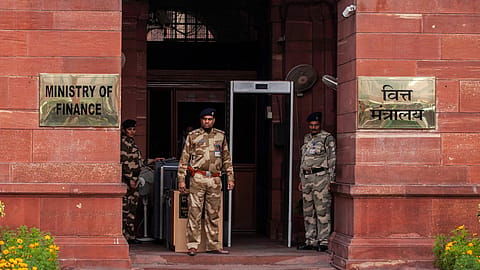FinMin sees opportunity in trade shifts amid Trump's tariff threat, calls for continued domestic reforms
FinMin says India can mitigate these risks and capitalise on emerging opportunities through strategic trade negotiations, domestic reforms and manufacturing investments

The Ministry of Finance, in its Monthly Economic Review for March 2025, said that while geopolitical uncertainties present challenges for India, they also offer an opportunity to strengthen its position in international trade and manufacturing by leveraging its comparative advantages in select goods and services.
"With renewed and sustained focus on geopolitical developments, India can mitigate these risks and capitalise on emerging opportunities through strategic trade negotiations, domestic reforms and manufacturing investments," the ministry has said in its latest Monthly Economic Review edition.
The report highlights strong macro-fundamentals, saying India’s long-term growth is driven by macroeconomic stability, a resilient external sector, declining fiscal deficit, easing inflation, improving employment prospects, and high consumption expenditure. It also underscores the role of private capital formation, which it said holds the key to the sustainability of this favourable constellation. "Public policy and regulatory measures can both facilitate and nudge the private sector to do its part. With the right strategies in place, continued domestic reforms, and a strong focus on infrastructure development and job creation, the economy can demonstrate resilient growth despite global uncertainties."
In FY26, prospects of the agriculture sector remain bright, supported by healthy reservoir levels and robust crop production. Manufacturing activity is also seen showing signs of revival with robust business expectations. Services sector activity continues to be resilient as well. On the demand side, the ministry says the favourable outlook for the agricultural sector augurs well for rural consumption, which remains robust. "Urban demand is showing steady improvement, supported by rising discretionary spending. On balance, labour market conditions remained stable. Several outlook surveys reflect optimism regarding employment conditions in the coming year, although they may have been conducted before the fresh round of tariffs announced in April."
In terms of investment activity, a momentum has been seen, which is expected to strengthen further, driven by sustained capacity utilisation, the government’s continued emphasis on infrastructure development, healthy balance sheets of banks and corporates, and easing financial conditions. The ministry forecasts that merchandise exports may also face pressure due to global uncertainties, and services exports will likely maintain their resilience. "Nonetheless, risks from ongoing global trade disruptions warrant close monitoring and diversification into various hitherto unexplored markets. For the private sector, this is the time to invest in product differentiation and quality as easy pickings recede into history."
The ministry advocates for the removal of compliance, inspection and logistics hurdles. "Empirical research has shown that China’s exports grew faster in those sectors where import duties on inputs came down the most. With the government's strong commitment to fiscal consolidation, the availability of domestic savings to finance private sector investment has improved. Going forward, the planned reduction of public debt to GDP will create additional domestic resources for private investment, especially as states also work to decrease their debt burdens. As a result, fiscal discipline is expected to enhance the momentum of economic growth."
There are expectations that food inflation will ease out in the near future as uncertainties around the rabi crop have largely resolved, and the second advance estimates point to record wheat output and higher pulse production. This disinflationary trend is reinforced by robust kharif arrivals and a sharp decline in inflation expectations, as seen in the recent RBI surveys.
Recommended Stories
"The falling crude oil prices could also contribute to the positive outlook. However, global uncertainties, such as trade tensions and geopolitical risks, could disrupt supplies or cause prices to rise or both," the ministry adds.
US President Donald Trump issued an Executive Order on reciprocal tariffs on April 2, 2025, imposing additional ad valorem duties ranging from 10% to 50% on imports from all trading partners. The baseline duty of 10% was supposed to be effective from April 5, and the remaining country-specific additional ad valorem duties were supposed to be effective from April 9. But Trump soon implemented a temporary pause on certain tariffs by introducing a 90-day delay on the variable tariffs for all countries, except China.
The additional US duty on India is 26%, but India is negotiating a bilateral trade deal with the US before the 90-day deadline ends. The duty on India is lower than the reciprocal tariffs announced for other Asian emerging market peers, such as China, Vietnam, Bangladesh, Thailand and Indonesia.